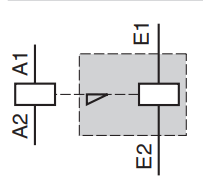Information: Operation of an LAD* Mechanical Latch Block
A pulse on the contactor coil (terminals A1 & A2) causes the contactor to close. The LAD* module mechanically latches and holds the contactor closed. A pulse on the LAD coil (terminals E1 & E2) opens the contactor: Note this means you need 2 control signals, one for the contactor coil and a separate one for the latch block coil.
The duration of the control signal for the mechanical latch block and the contactor should be:

A pulse on the contactor coil (terminals A1 & A2) causes the contactor to close. The LAD* module mechanically latches and holds the contactor closed. A pulse on the LAD coil (terminals E1 & E2) opens the contactor: Note this means you need 2 control signals, one for the contactor coil and a separate one for the latch block coil.
The duration of the control signal for the mechanical latch block and the contactor should be:
- >= 100 ms for a AC coil contactors
- >= 250 ms for a DC coil contactors
Released for:Schneider Electric UK
Information: Operation of an LAD* Mechanical Latch Block
A pulse on the contactor coil (terminals A1 & A2) causes the contactor to close. The LAD* module mechanically latches and holds the contactor closed. A pulse on the LAD coil (terminals E1 & E2) opens the contactor: Note this means you need 2 control signals, one for the contactor coil and a separate one for the latch block coil.
The duration of the control signal for the mechanical latch block and the contactor should be:

A pulse on the contactor coil (terminals A1 & A2) causes the contactor to close. The LAD* module mechanically latches and holds the contactor closed. A pulse on the LAD coil (terminals E1 & E2) opens the contactor: Note this means you need 2 control signals, one for the contactor coil and a separate one for the latch block coil.
The duration of the control signal for the mechanical latch block and the contactor should be:
- >= 100 ms for a AC coil contactors
- >= 250 ms for a DC coil contactors
Released for:Schneider Electric UK





